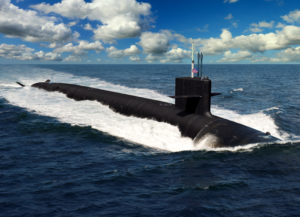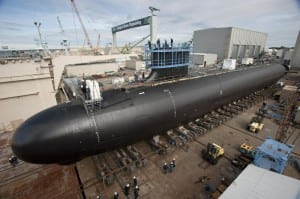Production on the first new Columbia-class ballistic missile submarine (SSBN) is 10 percent behind schedule while Virginia-class attack submarines (SSN) are improving but still significantly behind schedule themselves, the Secretary of the Navy told a congressional panel this week.
“In fact, I think we do have clear visibility into the challenges that Columbia faces. She’s currently about 10 percent behind schedule is what she is, given the challenges that were faced with COVID and supply chains not being able to get the advanced procurements that are necessary to be able to fulfill those requirement leads to her being 10 percent behind. Having said that, we want to try to obviously close that gap in every possible way,” Secretary Carlos Del Toro said March 29 during a hearing before the House Appropriations Committee’s defense subcommittee.

Del Toro was responding to a question from Subcommittee Chairman Ken Calvert (R-Calif.) about submarine on-time delivery after he cited a January Government Accountability office study that said the Navy program needed an updated schedule risk analysis to better assess the feasibility of the current schedule and identify risks (Defense Daily, Jan. 24).
Del Toro said the Navy was thankful for over $2 billion in submarine industrial base investments that Congress allocated in the fiscal year 2023 budget to help improve submarine production timelines.
“Those investments are being put to good use through the developments of pilots all across the country, starting with the one in Connecticut, that’s called RTS basically is the model to try to improve the workforce development issues that are at play there. The shortage of workers in the submarine community and across the nation is obviously a national challenge that we all have to address collectively,” he said.
Del Toro repeated his support for increasing legal immigration to help improve the blue collar workforce, including adding to the submarine force.
“We are working very closely with industry to try to close these gaps to the best we can.”
The Navy previously planned for the first Columbia-class submarine to be delivered within 78 months of start of construction, six months faster than the original timeline of 84 months to add more time for margin if the work could proceed at the faster pace. However, much of the margin was lost due to welding mistakes made by BWX Technologies [BWXT] to a dozen common missile tubes.
Last November, Adm. Scott Pappano, Program Executive Officer for Strategic Submarines, said the first submarine now holds only one more month of margin due to the missile tube issue and the earlier startup challenges both HII [HII] and General Dynamics Electric Boat [GD] had with digital work instructions (Defense Daily, Nov. 1, 2022).
The January GAO report underscored the Navy planned for the Columbia-class submarine to be produced in less time than was planned for the lead Virginia-class SSN and that lead vessels of the three last attack submarine classes all took significantly longer to build than the service initially estimated.
The Navy is looking to deliver the first new SSBN by 2027 so it can complete years of testing needed before it can conduct its first patrol. Given the little to no margins in the schedule, officials have said they have until fiscal year 2026 to decide if they will start to extend the life of up to five current Ohio-class SSBNs to add time back in (Defense Daily, Nov. 2, 2022).
Calvert also cited construction of Virginia-class submarines as down at 1.2 per year rather than the two per year the government is funding and aiming for.

In January, Chief of Naval Operations Adm. Mike Gilday said the shipbuilding industry needed to prove it could build ships the government wants at a faster rate given higher funding, citing the then-current rate of only 1.2 SSNs annually (Defense Daily, Jan. 11)
Del Toro noted SSN production has improved somewhat.
“On the Virginia side of the house, you are right, they are significantly behind. They should be at two boats per year. They are currently around 1.4, so they have made some progress of moving in that direction.”
The secretary said he was particularly concerned about constructing the sterns and bows of SSNs at HII’s Newport News Shipbuilding facility in Virginia and getting them up to General Dynamics Electric Boat in Connecticut to connect the pieces.
“So we do have a far better job to do and we are holding industry accountable in every which we possibly can and working with them at the same time to try to close these gaps.”
Construction of both the SSBNs and SSNs are split between GD Electric Boat and HII Newport News Shipbuilding under an agreement in which GD builds the middle parts with the reactor compartment while HII makes the bows and sterns. The shipyards take turns with final assembly on the Virginia-class boats.